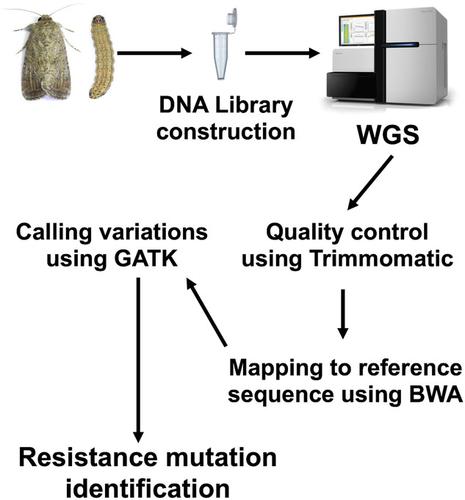当前位置:
X-MOL 学术
›
Insect Sci.
›
论文详情
Our official English website, www.x-mol.net, welcomes your
feedback! (Note: you will need to create a separate account there.)
Whole‐genome sequencing to detect mutations associated with resistance to insecticides and Bt proteins in Spodoptera frugiperda
Insect Science ( IF 2.9 ) Pub Date : 2020-08-04 , DOI: 10.1111/1744-7917.12838 Fang Guan 1 , Jianpeng Zhang 1 , Huiwen Shen 1 , Xingliang Wang 1 , Amanda Padovan 2 , Tom K Walsh 2 , Wee Tek Tay 2 , Karl H J Gordon 2 , William James 2 , Cecilia Czepak 3 , Michael Hilary Otim 4 , Donald Kachigamba 5 , Yidong Wu 1
Insect Science ( IF 2.9 ) Pub Date : 2020-08-04 , DOI: 10.1111/1744-7917.12838 Fang Guan 1 , Jianpeng Zhang 1 , Huiwen Shen 1 , Xingliang Wang 1 , Amanda Padovan 2 , Tom K Walsh 2 , Wee Tek Tay 2 , Karl H J Gordon 2 , William James 2 , Cecilia Czepak 3 , Michael Hilary Otim 4 , Donald Kachigamba 5 , Yidong Wu 1
Affiliation

|
The fall armyworm, Spodoptera frugiperda, is a major pest native to the Americas that has recently invaded the Old World. Point mutations in the target-site proteins acetylcholinesterase-1 (ace-1), voltage-gated sodium channel (VGSC) and ryanodine receptor (RyR) have been identified in S. frugiperda as major resistance mechanisms to organophosphate, pyrethroid and diamide insecticides respectively. Mutations in the ATP-binding cassette transporter C2 gene (ABCC2) have also been identified to confer resistance to Cry1F protein. In this study, we applied a whole-genome sequencing (WGS) approach to identify point mutations in the target-site genes in 150 FAW individuals collected from China, Malawi, Uganda and Brazil. This approach revealed three amino acid substitutions (A201S, G227A and F290V) of S. frugiperda ace-1, which are known to be associated with organophosphate resistance. The Brazilian population had all three ace-1 point mutations and the 227A allele (mean frequency = 0.54) was the most common. Populations from China, Malawi and Uganda harbored two of the three ace-1 point mutations (A201S and F290V) with the 290V allele (0.47-0.58) as the dominant allele. Point mutations in VGSC (T929I, L932F and L1014F) and RyR (I4790M and G4946E) were not detected in any of the 150 individuals. A novel 12-bp insertion mutation in exon 15 of the ABCC2 gene was identified in some of the Brazilian individuals but absent in the invasive populations. Our results not only demonstrate robustness of the WGS-based genomic approach for detection of resistance mutations, but also provide insights for improvement of resistance management tactics in S. frugiperda. This article is protected by copyright. All rights reserved GRAPHICAL ABSTRACT: A whole-genome sequencing (WGS) approach was used to identify mutations associated with resistance to insecticides and Bt proteins in 150 individuals of Spodoptera frugiperda collected from China, Malawi, Uganda and Brazil.
更新日期:2020-08-04











































 京公网安备 11010802027423号
京公网安备 11010802027423号